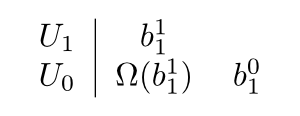Beispiel 1
Gegeben sei die Matrix \(A \in \mathbb{R}^{2 \times 2}\):
.
Jordannormalform bestimmen
1. Charakteristisches Polynom berechnen: \(p_A(\lambda) = (\lambda - 1)^2\).
Daraus folgt: \(\lambda = 1\) ist einziger Eigenwert \(\Rightarrow\) 1 Jordanblock
2. Anzahl der Jordankästchen bestimmen:
\(\Rightarrow\) es gibt genau 1 Jordankästchen in diesem Jordanblock.
.
Basiswechselmatrix bestimmen
Basisvektoren für den Eigenwert 1 bestimmen:
,

Wähle
Beispiel 2
Gegeben sei die Matrix \(A \in \mathbb{R}^{2 \times 2}\):
.
Jordannormalform bestimmen
1. Charakteristisches Polynom berechnen:
Daraus folgt: 0 und 1 sind Eigenwerte. Sie haben jeweils die algebraischen Vielfachheit 1. Daraus folgt: Die Jordansche Normalform hat genau zwei Jordanblöcke, die beide die Größe 1x1 haben. Daraus folgt: Beide Jordanblöcke haben genau ein Jordankästchen der Größe 1x1. Daraus folgt: Die Jordansche Normalform der Matrix ist:
Basiswechselmatrix bestimmen
Basisvektoren für den Eigenwert 0 bestimmen:
Basisvektoren für den Eigenwert 7 bestimmen:
Zusammensetzen:
Anmerkung
Man hätte übrigens jeden Vektor aus
nehmen können. Angenommen, man hätte den Vektor
gewählt:
Das gleiche gilt natürlich für jeden anderen gewählten Vektor. Die inverse Matrix ändert sich selbstverständlich, jedoch nicht die Jordansche Normalform oder die ursprüngliche Matrix.